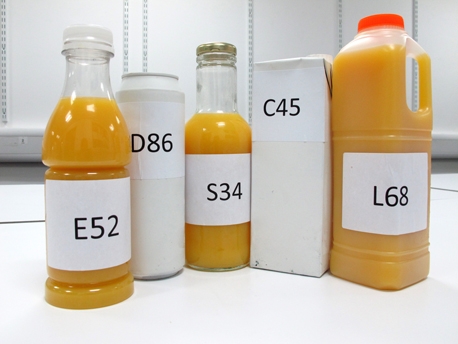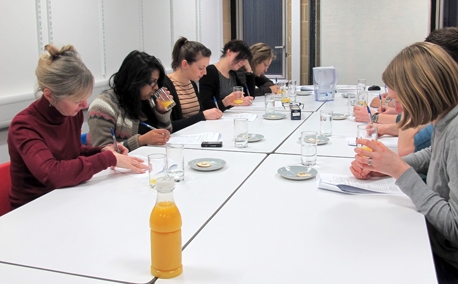FEATURE20 July 2012
All MRS websites use cookies to help us improve our services. Any data collected is anonymised. If you continue using this site without accepting cookies you may experience some performance issues. Read about our cookies here.
FEATURE20 July 2012
Research shows that the same orange juice can taste and smell different when presented in different packaging. Stergios Bititsios says the implications for NPD are huge.

Measuring whether someone likes a product will not tell you whether it has the ability to forge a strong and long-lasting relationship with the consumer. Think about it this way: you are not good friends with someone just because you like them. There is more that defines and maintains the relationship. It is the perceptions, or ‘conceptualisations’, we form about someone and associate with them that are the true drivers of friendship.
Likewise, when deciding whether to commit to a brand or product we take into account a range of different things beyond the simple determination that we ‘like’ something. One of these factors has to do with the packaging. At MMR Research Worldwide, we have shown that packaging in its own right has the power to influence brand and product perceptions. But more recently our experience in packaging research and sensory science led us to asks if packaging can also influence how consumers perceive the sensory qualities of products.
In other words, a pack’s format alone may affect the way we judge the aroma, flavour and mouthfeel of a drink product, for example. If true, this would add a new dimension to the field of packaging research and innovation.
Sensory profiling
We acquired an existing, branded ambient orange juice that comes in a carton container and invited our sensory panel to objectively profile it. The permanent panel consists of carefully screened and trained individuals whose increased sensory acuity allows them to detect and describe the sensory qualities of a product, regardless of product category. We deliberately avoided revealing the brand and packaging to eliminate bias.
After analysis and evaluation of the aroma, flavour and mouthfeel of the selected orange juice the panel extracted the following attributes:
Aroma
Overall orange strength, fresh, artificial, plastic
Flavour
Overall orange strength, citrusy, zesty, fresh, artificial, sweet, acid, bitter, plastic
Mouthfeel
Smooth, thick, dry
Consumer evaluation
We then invited 100 consumers, divided into groups of ten, to evaluate the product against the sensory attributes identified in stage one. Although we had only the one product to test, consumers were told that they would be evaluating a range of six different orange juices.
In every session, each consumer was first provided with a 100ml sample, served in a clear glass – no packaging – and a list of the attributes. This was to calibrate consumers’ taste buds and to make sure that they could relate the listed attributes to the product under evaluation.

Once this phase had been completed the consumers were ready to proceed to a full product evaluation exercise. The samples were served one at a time, as before, in clear glasses and poured out of sight of the consumers so they could not see the original packaging. Consumers were asked to slowly drink the juice and rate the intensity of the listed attributes on a five-point rating scale.
They were then asked to repeat the process for the remaining five samples. The difference was that the next five samples were presented with packaging. Every group saw the packaging examples in a different order. Rotating the order in which the packs were presented was essential from a research perspective, as it ensured that no pack was constantly seen first or last which could have skewed consumers’ responses.
The glasses of juice were distributed and the pack placed, as if casually left behind, at the edge of the table. The consumers were not prompted to either look or interact with the packaging.
Analysis and results
We analysed the consumer data and found differences in the way consumers responded to the different samples, despite the fact they had consumed the same product. When we examined the data further, we found statistically significant differences between three key attributes: ‘overall orange strength in taste’, ‘tastes citrusy’ and ‘feels thick in mouth’. All are extremely important in the orange juice category.
Overall orange strength in taste:
The sample that consumers thought came in the translucent plastic bottle with a handle and the one they thought came in a carton scored significantly higher on ‘overall orange strength in taste’ than the rest of the samples. The sample that was presented without packaging came last with a statistically significant difference from the rest.
Tastes citrusy: All the samples that presented with packaging scored significantly higher than the sample without packaging. The samples consumers thought came in the clear plastic bottle scored significantly higher than the rest. We also plotted the six samples and the selected sensory attributes on a map to indicate the relative position of products and their attributes in the consumers’ perceptual space. No packaging: Less artificial, fresher, not overly sweet, easy to drink, smelled of freshly squeezed oranges. Translucent plastic bottle with handle: Less strong, sweet, artificial, acidic, bitter. Glass bottle: strongest orange taste, overall strong taste, bitter, feels weaker, diluted, understated. Clear plastic bottle: good balance of sweetness and acidity, natural, flavourful and balanced, most orangey, real oranges, acidic, bitter. Carton: bland, plasticy. It is astonishing to see such great differences in perception knowing that the products were identical. Undoubtedly, then, packaging format plays a key role in how consumers perceive the intensity of the flavour, aroma and mouthfeel of a product. The implication for R&D and marketing teams is that every time a new product is developed, packaging should be explored and developed alongside it. The pack must be in line with the sensory qualities of the product if manufacturers want to make the most out of their new proposition. In the case of ambient orange juice, if a manufacturer wants to develop a more citrusy product, translucent plastic seems like a more appropriate packaging format, while glass sits at the other end of the scale. Similarly if ‘thickness in mouth’ is seen as a key product attribute then clear and rigid plastic is the right packaging material. And this is before we explore the surely significant role of shape and graphics. These findings can be generalised to include other product categories and senses – i.e. the sound of a crunchy chocolate bar, the visual texture of a dishwashing tablet, the tactile texture of a cream. All these sensory qualities can be potentially ruined in consumers’ minds if not captured in the packaging design process. Clearly, packaging can be used as a vehicle not only to communicate brand values and product benefits but also to control sensory perceptions. The results of this study flag up the importance of packaging in the consumption experience and clearly stress the need for in-depth consumer research throughout the packaging innovation process. Stergios Bititsios is associate director, packaging and design, at MMR Research WorldwideFeels thick in mouth:
At the end of each session we also collected anecdotal evidence to back up our statistical analysis. We asked consumers to tell us from memory which samples they liked and disliked the most and why. Below are some descriptions expressed in consumers’ natural language:
7 Comments
justincharlton-jones@marketmeasures.co.uk
12 years ago
I'm not sure that this is news to anyone regularly involved in product testing, which is why products are usually presented in a neutral environment without visible packaging to avoid any potential bias that might be introduced by a brand name or pack. This is an issue for pack testing research and reinforces the need to include an element of sensory testing when a packaging format is changed significantly from that which the consumer is used to.
Like Reply Report
Chris Duston
12 years ago
Packaging affects the product inside. Shape and material of the packaging affect the amount of UV that reaches the product, the heat retained in the product, the oxidation of the product, among other effects. These factors affect the chemical and physical properties of the product - especially volatile products such as foods and cosmetics. Through experience consumers learn to associate certain differences in product characteristics with certain types of packaging. Consumers expectations influence their perceptions. Those perceptions are related to a schema of other social and aspirational values. For example, glass allows less oxidation of sugars than plastic does, so products in glass tend to taste sweeter than products in plastic. Moreover the perception of sweetness is associated with other values - like freshness, which is associated with health, which has a premium value and generates a higher willingness to pay. The key research objective is to map the packaging elements to the consumer expectations and then to the benefits and values in a particular category. Based on such a mapping, research leads the marketer to use the packaging that supports the benefits and values that the marketer has set as an objective. This mapping process should include socially-oriented qual research, semiotic approaches, and sensory research. Sensory research, unfortunately, up to this point is quite underutilized considering the great value it adds to marketing. This article was excellent example of demonstrating the scientific rigour of sensory research, the practicality of conducting such research, and very robust and clear conclusions for marketers.
Like Reply Report
Mike
12 years ago
I think is a good research. keep it up.
Like Reply Report
Neil Higgs
12 years ago
We have been doing pack tests as product tests for years for this very reason. The only thing that matters. besides design elements that offend or confuse, is the effect a pack has on perceptions of the product and on the brand.
Like Reply Report
Ron
12 years ago
Nice Test. The Mindless Eating book had similar types of tests and had the same conclusion: Identical foods can "taste" very different, as perception affects how humans "taste" food. Taste is such a complex topic I find it a bit overwhelming. Ambiance, packaging, color, advertising all play a role. I am not sure that packaging has such a large effect on non-foods though.
Like Reply Report
Anon
12 years ago
'It is astonishing to see such great differences in perception knowing that the products were identical.' I've never found my supermarket carton of OJ (concentrate) consistent, and certainly not the fresh stuff either. So, about 70 litres of OJ was mixed (more if you include the in-house team) to produce an identical sample. It's hard to believe. Also, the idea you can 'calibrate consumers’ taste buds'. Drinking over half a litre of OJ must have some effect on the individual palate. Still, presumably no one had a cold for months.
Like Reply Report
Dani
12 years ago
They could have inserted a real different juice.. to see if there would be a significant change on the answers. And then compare which is the package that most changes the perceptions. I only see people conviced they understand about juice and giving random answers....
Like Reply Report